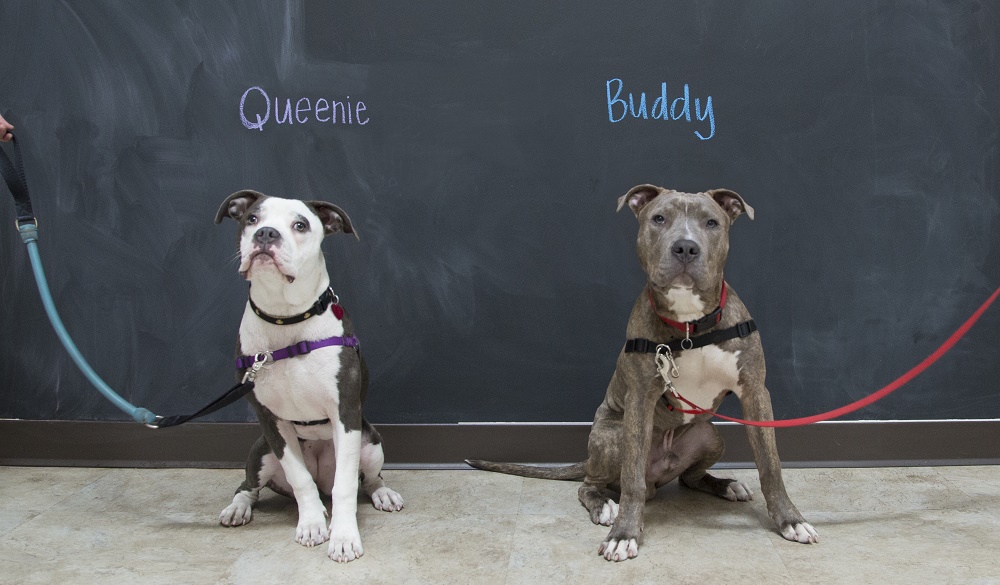By Ellie Whitcomb Payne
A proactive training approach encourages early muzzle introduction and aims to remove the stigma of its use.
One of the common reasons people think to muzzle dogs is to avoid biting incidents, but in actuality, dog owners, trainers and veterinarians use muzzles to prevent a much broader array of behaviors. Today, a movement seems to be taking hold promoting the responsible use of muzzles, emphasizing training at a young age and destigmatizing the image of the mean, muzzled dog.
KEEP A GOOD DOG GOOD
In puppy training classes at Charleston Animal Society, exploration stations offer young dogs opportunities to experience different items, such as nail clippers and stethoscopes, in a non-threatening and rewarding environment. One of these stations features the basket muzzle. “Often, owners are taken aback when we introduce the muzzle training with their puppies,” says Caitllin Kuczko, licensed dog trainer with the organization’s Canine College. But the truth is, you never know when this valuable tool might come in handy. Perhaps an emergent situation, such as a hurricane forces your family into unfamiliar and stressful living conditions, or your puppy exhibits symptoms of an eating disorder. “We feel it is important to train your dog to be comfortable with the muzzle early on, so that if you need it, your pet is ready,” says Kuczko. “Muzzles help to keep a good dog good,” she adds, quoting SPCA colleague Jeannie Brousseau, RVT.
CONDITIONING AND MUZZLE USE OFFER A NEW LEASE ON LIFE
Captain came to Charleston Animal Society in a dismal state, abused and emaciated. After processing and observation within the shelter, a family adopted him only to quickly return him after two attacks on other animals. Donya Saltriale, licensed behaviorist with Charleston Animal Society, decided to take in the nervous and untrained American bulldog mix. Saltriale praises the muzzle as the saving grace that allowed her to safely, and cautiously, socialize the pup. Using the tool in conjunction with behavior training over the span of a year, Saltriale was able to gradually desensitize Captain to other dogs and cats, without the added risk associated with his bite history. Captain’s experience demonstrates that muzzles are not solutions on its own, but tools to help reach desired behavioral goals. “You can’t use a muzzle to make a dog into something he is not. I think the key should be to understand your dog’s stressors and not put him in situations where he would be dangerous to himself or others,” emphasizes Saltriale. She adds that Captain “will never be a dog-park dog, but, because of training with the help of the muzzle, he is able to be around other dogs without being reactive anymore.”
MUZZLE UP
Through education, San Francisco based non-profit The Muzzle Up! Project aims to change public perception about the use of muzzles. The founder, Maureen Backman, MS, CTC, PCT-A, hosts training sessions all over the country on the correct use of basket muzzles. She notes that muzzles are still somewhat of a touchy subject, even among people who are knowledgeable about training and advocate animal welfare. “Right now, muzzles are seen as a last-minute solution for a vicious dog that may be biting,” says Backman. “Instead, my goal is for people to see muzzles as a training tool just as they would see a front-leading harness.” She, like Kuczko, also believes in early introduction so that in an emergency, if a muzzle is needed, it does not add undue stress.
As positive reinforcement training becomes more popular across the country, the proper introduction and use of basket muzzles is more widely regarded as the humane way to protect dogs from negative experiences. Saltriale reflects that the muzzle may have saved Captain’s life. “If I took a chance and he bit someone through the training process, I would have put him to sleep,” she reflects. “That was not a chance I was willing to take.” While every dog may not ever need a muzzle, it might be smart to introduce the tool at a young age. Muzzles should never be used without proper training and a muzzled dog should not be left unsupervised. If you’re thinking about using one on your pet, speak with your veterinarian or licensed dog trainer before purchase.





